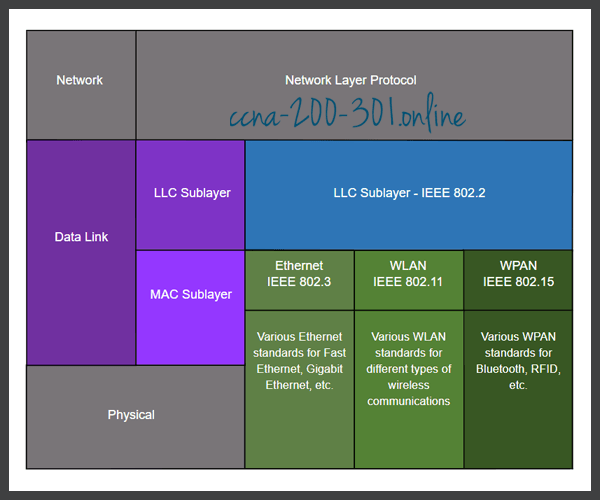Purpose of the Data Link Layer
Summary
This topic describe the purpose and function of the data link layer in preparing communication for transmission on specific media. Start learning CCNA 200-301 for free right now!!
Table of Contents
The Data Link Layer
The data link layer of the OSI model (Layer 2), as shown in the figure, prepares network data for the physical network. The data link layer is responsible for network interface card (NIC) to network interface card communications. The data link layer does the following:
- Enables upper layers to access the media. The upper layer protocol is completely unaware of the type of media that is used to forward the data.
- Accepts data, usually Layer 3 packets (i.e., IPv4 or IPv6), and encapsulates them into Layer 2 frames.
- Controls how data is placed and received on the media.
- Exchanges frames between endpoints over the network media.
- Receives frames from the physical layer, decapsulates them, and delivers the resulting Layer 3 packets to the network layer.
- Performs error detection and rejects any corrupt frame.

In computer networks, a node is a device that can receive, create, store, or forward data along a communications path. A node can be either an end device such as a laptop or mobile phone, or an intermediary device such as an Ethernet switch.
Without the data link layer, network layer protocols such as IP, would have to make provisions for connecting to every type of media that could exist along a delivery path. Additionally, every time a new network technology or medium was developed IP, would have to adapt.
The figure displays an example of how the data link layer adds Layer 2 Ethernet destination and source NIC information to a Layer 3 packet. It would then convert this information to a format supported by the physical layer (i.e., Layer 1).

IEEE 802 LAN/MAN Data Link Sublayers
IEEE 802 LAN/MAN standards are specific to Ethernet LANs, wireless LANs (WLAN), wireless personal area networks (WPAN) and other types of local and metropolitan area networks. The IEEE 802 LAN/MAN data link layer consists of the following two sublayers:
- Logical Link Control (LLC) – This IEEE 802.2 sublayer communicates between the networking software at the upper layers and the device hardware at the lower layers. It places information in the frame that identifies which network layer protocol is being used for the frame. This information allows multiple Layer 3 protocols, such as IPv4 and IPv6, to use the same network interface and media.
- Media Access Control (MAC) – Implements this sublayer (IEEE 802.3, 802.11, or 802.15) in hardware. It is responsible for data encapsulation and media access control. It provides data link layer addressing and it is integrated with various physical layer technologies.
The figure shows the two sublayers (LLC and MAC) of the data link layer.

The LLC sublayer takes the network protocol data, which is typically an IPv4 or IPv6 packet, and adds Layer 2 control information to help deliver the packet to the destination node.
The MAC sublayer controls the NIC and other hardware that is responsible for sending and receiving data on the wired or wireless LAN/MAN medium.
The MAC sublayer provides data encapsulation:
- Frame delimiting – The framing process provides important delimiters to identify fields within a frame. These delimiting bits provide synchronization between the transmitting and receiving nodes.
- Addressing – Provides source and destination addressing for transporting the Layer 2 frame between devices on the same shared medium.
- Error detection – Includes a trailer used to detect transmission errors.
The MAC sublayer also provides media access control, allowing multiple devices to communicate over a shared (half-duplex) medium. Full-duplex communications do not require access control.
Providing Access to Media
Each network environment that packets encounter as they travel from a local host to a remote host can have different characteristics. For example, an Ethernet LAN usually consists of many hosts contending for access on the network medium. The MAC sublayer resolves this. With serial links the access method may only consist of a direct connection between only two devices, usually two routers. Therefore, they do not require the techniques employed by the IEEE 802 MAC sublayer.
Router interfaces encapsulate the packet into the appropriate frame. A suitable media access control method is used to access each link. In any given exchange of network layer packets, there may be numerous data link layers and media transitions.
At each hop along the path, a router performs the following Layer 2 functions:
- Accepts a frame from a medium
- De-encapsulates the frame
- Re-encapsulates the packet into a new frame
- Forwards the new frame appropriate to the medium of that segment of the physical network
The router in the figure has an Ethernet interface to connect to the LAN and a serial interface to connect to the WAN. As the router processes frames, it will use data link layer services to receive the frame from one medium, de-encapsulate it to the Layer 3 PDU, re-encapsulate the PDU into a new frame, and place the frame on the medium of the next link of the network.

Data Link Layer Standards
Data link layer protocols are generally not defined by Request for Comments (RFCs), unlike the protocols of the upper layers of the TCP/IP suite. The Internet Engineering Task Force (IETF) maintains the functional protocols and services for the TCP/IP protocol suite in the upper layers, but they do not define the functions and operation of the TCP/IP network access layer.
Engineering organizations that define open standards and protocols that apply to the network access layer (i.e., the OSI physical and data link layers) include the following:
- Institute of Electrical and Electronics Engineers (IEEE)
- International Telecommunication Union (ITU)
- International Organization for Standardization (ISO)
- American National Standards Institute (ANSI)
The logos for these organizations are shown in the figure.
Engineering Organization Logos

Ready to go! Keep visiting our networking course blog, give Like to our fanpage; and you will find more tools and concepts that will make you a networking professional.





